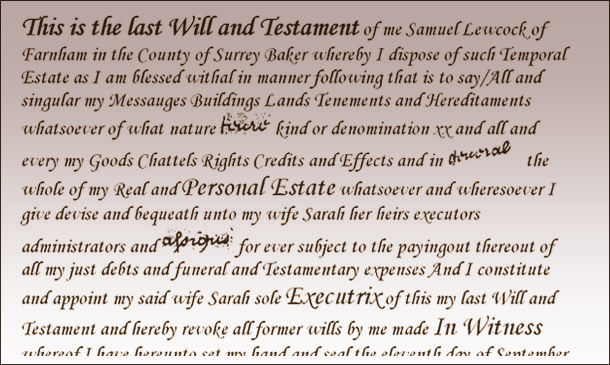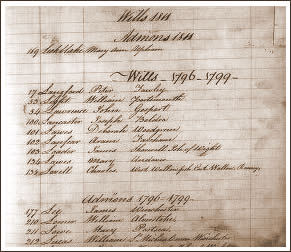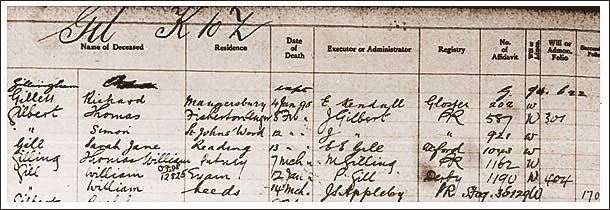Difference between revisions of "Wills and Probate"
Jessbowbag (talk | contribs) |
Jessbowbag (talk | contribs) |
||
| Line 176: | Line 176: | ||
-Prerogative & Exchequer Courts of York Probate Index 1853-1858 | -Prerogative & Exchequer Courts of York Probate Index 1853-1858 | ||
| − | *[http://www.cityoflondon.gov.uk/scripts/htm_hl.pl?DB=col&STEMMER=en&WORDS=archdeaconry%20court%20middlesex%20wills&ALL=&ANY=&EXACTB=0&PHRASE=&EXACTP=0&CATEGORIES=&SIMPLE=%20Archdeaconry%20Court%20of%20Middlesex%20Wills&COLOUR=Red&STYLE=s&URL=http://www.cityoflondon.gov.uk/Corporation/applications/wills/London_Signatures_FAQs.htm#muscat_highlighter_first_match London Signatures] | + | *[http://www.cityoflondon.gov.uk/scripts/htm_hl.pl?DB=col&STEMMER=en&WORDS=archdeaconry%20court%20middlesex%20wills&ALL=&ANY=&EXACTB=0&PHRASE=&EXACTP=0&CATEGORIES=&SIMPLE=%20Archdeaconry%20Court%20of%20Middlesex%20Wills&COLOUR=Red&STYLE=s&URL=http://www.cityoflondon.gov.uk/Corporation/applications/wills/London_Signatures_FAQs.htm#muscat_highlighter_first_match London Signatures] Archdeaconry Court of Middlesex Wills (AM/PW) 1609 - 1810. |
*[http://www.cheshire.gov.uk/familyhistory/wills.htm Cheshire Records Office] - online catalogue and ordering facility | *[http://www.cheshire.gov.uk/familyhistory/wills.htm Cheshire Records Office] - online catalogue and ordering facility | ||
Revision as of 08:12, 26 September 2009
Contents
What do you find in a will?
- The name of the testator (the person making the will)
- His address, and usually his occupation
- The date the will was written
- Bequests which may be to family, friends, neighbours or charities
- The executors, people trusted to carry out his wishes
- The testator’s signature
- Signatures of at least two witnesses (who must not benefit from the will.)
- The date probate was granted (ie the document was agreed to be the testator’s last will and testament), and to whom.
- Where the testator wants to alter a provision or change a beneficiary. a codicil will note these changes and be filed with the will.
Why is the information useful?
Wills may mention dead ancestors, pregnant wives, married daughters, grandchildren.... You cannot tell how much detail a will may contain until you’ve read it. A will may be the only document to link branches of the family living in different counties, particularly after 1901.
You have a snapshot of circumstances when the will was made, not when the testator died.
How to look for a death
Before 1837 and after about 1912, it may be quicker to search a will index, as death will have occurred between the dates of will and probate. Though be warned that some wills are proved long after death in one case 76 years later.
Probate may show that the original executor has died, or is unwilling to act, and explain why someone else takes their place.
What a will does not tell you is someone’s full fortune. Land is generally not mentioned in wills.
Conversely, some people's wills totalled more than their assets!
Boys may have been put to a trade or had a farm bought for them; girls may have had a marriage settlement made on them. Where a child has already been given their share, they may not be mentioned in a will.
If you are looking at an original will, then you can see your ancestor’s actual signature or mark. If it is a registered copy (like the PCC wills you can download from Documents Online) then the signatures will be copies.
Partial transcription of the Will of Samuel Lewcock Baker
When was the will proved?
Before 1858
Wills were proved in church courts. There are usually at least three courts where you might find an individual's will:
- The local Archdeaconry court
- The local Consistory or Commissary court
- Prerogative Court of Canterbury Index to Wills and Admons 1853-1857.
PCC wills up to 1857
Are available for download from the National Archives at a cost of £3.50 each. Searching is free. If you find an entry and you are not sure whether it is your ancestor / relative or not, you may find it is worth looking up the corresponding entry in the Index to Death Duty Registers to check the name and address of the executor.
PCC wills up to 1857
Some record offices also hold microfiches or microfilms of the above. The will index is not likely to be of much interest, as the information given for most entries is less than you would find with a search on the National Archives Documents Online, but the Admons Index contains entries which are not on Documents Online, so may be useful.
If you don't find a will, it is also worth looking for an Administration
National Probate Calendar ~ 1858 to the present day
The National Probate Calendar is an annual index to grants of probate and administration of deceased persons' estates in England and Wales, from 1858 up to the present day. The index has been microfilmed from 1858 up to 1943, and microfiches or microfilm of these years are available to view in many record offices and in some probate offices (not all years may be covered in any particular office). Some offices also have bound volumes for at least some of the years after 1943.
The entries for the years from 1858 up to 1870 are in separate sections for Probate (wills) and Administration (admons), while from 1871 onwards, both types of grant are listed together in the one index. The entries are listed by the year when the grant was made, which is not always the same as year of death. In most cases, probate or administration was granted within a year or two of death, but there are cases where many years elapsed in between.
As yet, there is no computerised index to the National Probate Calendar, so you have to search through year by year. If you know when the person you are looking for died, start at the year of their death and work forwards. The entries within each year are in order of surname, and then of first name(s) within surname.
A typical entry from the years 1858-1891 will tell you the full name of the deceased, including any aliases, the amount of his / her personal estate, date and place of death, occupation (or marital status for a woman), residence, and sometimes also previous residence, date and place where probate or administration was granted, and the names, occupations, residences and relationship (if any) to the deceased, of the executors / administrators.
From 1892 onwards, the residence and relationship to deceased of the executors / administrators is not given. From 1918 onwards, the occupation of the deceased is not given.
The entries in the National Probate Calendar pertain to people who had money and / or property in England and Wales (regardless of which country they actually died in) and some entries will give details of a Confirmation / Seal of probate or administration granted in another country, if part of the deceased's estate was held in England or Wales. For some years, Irish and Scottish entries are in a separate section, but for other years they are included in the main index. As well as Irish and Scottish entries, there are some from all over the world, although the details may not be as full as for English and Welsh entries.
If you find a Probate entry, or "Administration with Will" and you would like a copy of the will, you can order a copy from the probate office - Guide to obtaining copies of probate records The cost is £5, plus £1 for each extra copy. You can download the order form required from the same site (form number PA1S).
You can also order a copy of the letters of administration for a grant of administration in the same way (and for the same fee), but in most cases it will tell you very litle more than is contained in the National Probate Calendar entry itself. Of course, there are exceptions.
If you cannot get to an office which contains the National Probate Calendar for the year(s) you are interested in, then you can still order the will or letters of administration in the same way as above, as the £5 fee includes a search of 4 years, but if the grant was made outside the years you specify for the search, or if no grant was made, you will not get a refund. You can add extra 4-year search periods at a cost of £3 each.
Death Duty Registers
Death Duties were payable from 1796 to 1903. The National Archives have the entries for the years 1796 to 1811 available for download at The National Archives ~ DocumentsOnline
The website FindMyPast has the Index to Death Duty Registers available to view online. There is also a lot of information about the index on the same website.
The entries do not contain as much information as the actual Death Duty Register entries, but they can be useful, especially in the years before 1858 when it can be difficult to find out where a particular will was proved or admon granted. These indexes are not fully name-searchable, so you may have to search through a few different pages to find an entry, but each page only costs 1 credit to view, and you may spot other members of the same family while you are looking through. If you have no idea of what year the person died then it might work out too expensive and time-consuming to search through all the possible index pages, but if you have their year of death from, say, a death certificate or burial register entry then it would usually only be a matter of searching through a couple of years' worth of pages.
All images from Documents Online and subject to ©Crown Copyright
Wills and Testaments
Difference between a will and a testament
A will disposes of land, while a testament disposes of chattels.
Who could bequeath what and when
In the last years of Henry II a law of primogeniture was passed so that land passed to the heir. Real Estate went to the heir, personal estate may pass to other persons. It wasn’t possible to make a post-obit gift of land to anyone other than the heir, the gift had to take effect at once. If the heir consented to the gift and confirmed it however it could be valid. An exception to this was made in the case of burgage tenements in boroughs, which could be devised by will according to the custom of the town.
In 1540 the Statute of Wills gave a testator power to devise the whole of his freehold land held in free socage and two-thirds of that held by military service. A medieval testament of chattels disposed of all the chattels at the time of death. A will however only dealt with land held at the date of the will. Any land acquired after the date of the will could not be passed on until such time as the will was re-made. This restraint was removed by Victoria I.
Copyhold lands, and any estate in freehold that was less than a life interest, could pass by any will or testament that was sufficient to bequeath chattels.
In the thirteenth century there were restraints on where you bequeathed you goods. If you left a wife and children, one third had to go to the wife, one third to the children and one third could be disposed of as the testator wished. If he had a wife but no children, one half went to the wife: if he had children but no surviving wife, one half went to the children. The other half he could dispose of as he wished. The children divided their share equally amongst themselves. The heir would get no part unless he brought into account the value of his inheritance (the land). Every child who had been given and advancement had to put that back into the total before he could claim his “bairn’s part”. The “bairn’s part” was limited strictly to children; if a child had died his offspring took no share. This was probably law in England throughout the 12th and 13th centuries, it was maintained until 1692 in the province of York and was still in force in Scotland until the 1930’s (it may still be)
Statute 34 and 35 Henry VIII is enacted as follows:
That wills or testaments, made of any manors, lands, tenements or other hereditaments, by any woman covert, or person within the age of one and twenty years, idiot, or by any person de non sane memory, shall not be taken to be good or effectual in law.
This was the law until 1837, when the statute of Victoria I enacted as follows:
That no will made by any person under the age of twenty-one years shall be valid.
That no will made by any married woman shall be valid, except such a will as might have been made by a married woman before the passing of this Act.
The medieval viewpoint in England was that a wife could not make a will without her husband’s consent which could be revoked at any time before he suffered the will to be proved.
Prior to the act of 1837 boys the age of fourteen and girls the age of twelve were capable of making wills of chattels.
Some sources which may be of use
- Surrey Plus Wills Index The Surrey Plus Wills Index provides an index to names of people appearing in the wills of testators residing in the County of Surrey, England (and nine other Counties). Many of the wills have been transcribed.
-Bank of England Will Extracts Index 1717-1845
-Prerogative Court of Canterbury Wills Index 1750-1800
-Archdeaconry Court of London Wills Index 1700-1807
-York Medieval Probate Index 1267-1500
-York Peculiars Probate Index 1383-1883
-Prerogative & Exchequer Courts of York Probate Index 1853-1858
- London Signatures Archdeaconry Court of Middlesex Wills (AM/PW) 1609 - 1810.
- Cheshire Records Office - online catalogue and ordering facility
- Scotlands People – free index - entries are often so detailed you don't need to download the wills. They cost £5 each whether one page or 50 pages.
- The Probate Service This link gives some general advice and there is also a downloadable application form "application for a probate search". The form (known as a PA1S) can be used to apply to for example York for copy wills/ grant of probate and letters of administration. Link for tApplication form.
- Index to death duty registers 1796-1903 This is only an index, but it gives the name of the executor and the reference number of the probate which you can use to apply for a copy from the appropriate Record Office.
Back to Records Office Guide




